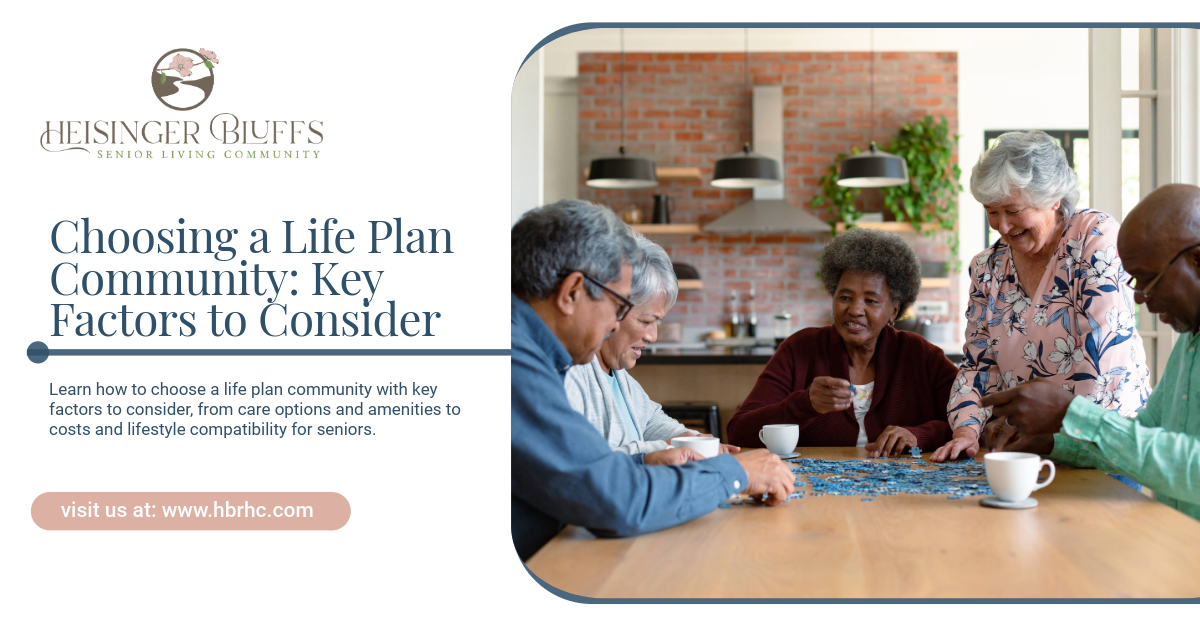Choosing a Life Plan Community: Key Factors to Consider

Key Highlights
- Life plan communities provide a continuum of care, from independent living to assisted living and memory care.
- Key factors include location, healthcare services, cost structure, and available amenities.
- Social engagement, wellness programs, and community culture influence overall satisfaction.
- Contract types, financial planning, and long-term stability are essential to review.
- Choosing the right community ensures safety, comfort, and a fulfilling lifestyle for seniors.
Selecting a life plan community is one of the most important decisions a senior or family can make. A life plan community—sometimes called a continuing care retirement community (CCRC)—offers a full spectrum of living options and services, designed to support residents as their needs change over time.
Making the right choice requires evaluating multiple factors, from healthcare services and amenities to costs and lifestyle compatibility. This guide will provide insights to help seniors and their families make an informed decision.
Understanding Life Plan Communities
Life plan communities are designed to offer long-term stability by providing:
- Independent Living: Private apartments or cottages for seniors who can live independently.
- Assisted Living: Support with daily activities like bathing, dressing, and medication management.
- Memory Care: Specialized programs for residents with Alzheimer’s or dementia.
- Skilled Nursing: On-site medical care for those with chronic illnesses or rehabilitation needs.
The continuum of care ensures residents can transition to higher levels of care without relocating, which provides peace of mind and continuity.
Factors to Consider When Choosing a Life Plan Community
1. Location and Accessibility
Location is a critical consideration when choosing a life plan community:
- Proximity to family and friends: Being close allows for frequent visits and emotional support.
- Nearby healthcare facilities: Access to hospitals and specialized medical providers is important.
- Community setting: Some seniors prefer urban environments with cultural and social activities, while others seek quiet suburban or rural locations.
- Transportation options: Shuttle services, public transit access, and accessibility for residents with mobility challenges are important.
The right location balances convenience, safety, and quality of life.
2. Healthcare Services and Staff Expertise
Healthcare services are a cornerstone of life plan communities:
- 24/7 nursing and emergency response: Ensures immediate assistance in medical situations.
- On-site doctors and therapists: Physical therapy, occupational therapy, and rehabilitation services.
- Personalized care plans: Tailored to individual needs and updated regularly.
- Memory care programs: Structured routines, cognitive therapies, and specialized staff for dementia care.
It’s essential to tour communities and ask about staff credentials, nurse-to-resident ratios, and medical oversight.
3. Cost Structure and Financial Considerations
Life plan communities often require careful financial planning:
| Cost Element | What to Expect |
|---|---|
| Entrance Fee | One-time upfront fee, sometimes refundable |
| Monthly Fee | Covers housing, meals, amenities, and care services |
| Care Costs | Additional charges for assisted living, memory care, or skilled nursing |
| Contract Types | Life care, modified, or fee-for-service options |
Key tips:
- Review contracts thoroughly and understand what is included and what may incur extra costs.
- Consider long-term financial planning to ensure sustainability throughout retirement.
- Consult with a financial advisor specializing in senior care.
5. Amenities and Lifestyle Options
The lifestyle offered by a community can greatly affect overall satisfaction:
- Social activities: Clubs, group classes, events, and outings.
- Wellness programs: Fitness centers, swimming pools, yoga, and personalized wellness plans.
- Dining options: Nutritious meals, flexible dining schedules, and accommodations for dietary restrictions.
- Cultural and educational opportunities: Workshops, lectures, art classes, and music programs.
- Outdoor spaces: Gardens, walking paths, and recreational areas.
A vibrant community enhances both physical and emotional well-being.
6. Community Culture and Social Environment
Beyond amenities, the social culture of a life plan community matters:
- Resident engagement: Observe interactions among residents and staff.
- Sense of belonging: Opportunities for meaningful friendships and community participation.
- Volunteer and intergenerational programs: Encourage involvement with local schools, charities, or clubs.
Visiting and participating in community events can help gauge the environment and determine if it aligns with personal preferences.
7. Contract Types and Legal Considerations
Understanding contract types is essential to protect finances and expectations:
- Life Care Contracts: Provide comprehensive care with predictable monthly fees.
- Modified Contracts: Include certain levels of care, with additional charges for higher levels.
- Fee-for-Service Contracts: Pay for care as needed; may have lower upfront costs but higher long-term expenses.
Ask about refund policies, fee increases, and what happens if a resident needs to move to a higher level of care. Legal and financial advice is recommended before signing.
8. Future Planning and Flexibility
Life plan communities are designed for long-term needs, but it’s important to consider:
- Transition policies: How smoothly residents can move between independent living, assisted living, and memory care.
- End-of-life care options: Availability of hospice or palliative care services.
- Adaptable housing: Units that accommodate mobility changes, accessibility needs, or family visits.
- Financial stability: Check the community’s financial health to ensure long-term sustainability.
Flexibility ensures residents are supported throughout all stages of life.
Questions to Ask When Touring Communities
When visiting potential life plan communities, ask:
- What is included in the monthly fee and entrance fee?
- What is the staff-to-resident ratio for assisted living and memory care?
- How are healthcare services and emergency responses managed?
- What social, wellness, and educational programs are available?
- Can residents customize their apartments or access private services?
- How are residents involved in decision-making or community governance?
Taking detailed notes and comparing answers will help make an informed decision.
Making the Decision
Choosing a life plan community is a combination of financial planning, lifestyle preferences, and healthcare needs. Consider:
- Balancing independence with security and support.
- Prioritizing long-term care options and accessibility.
- Evaluating amenities, social culture, and resident satisfaction.
- Consulting with financial advisors, family members, and healthcare professionals.
The right community provides peace of mind, social engagement, and a comfortable environment to enjoy retirement years fully.
Final Thoughts
Selecting a life plan community is a critical decision that impacts quality of life, healthcare access, and financial stability. By evaluating healthcare services, location, amenities, community culture, contract types, and costs, seniors and their families can choose a community that fits their needs today and in the future.
Heisinger Bluffs offers a comprehensive life plan community with independent living, assisted living, memory care, and skilled nursing services, ensuring seniors experience safety, wellness, and vibrant social engagement while planning for a secure future. Contact us today!
Frequently Asked Questions
What is a life plan community?
A life plan community offers a continuum of care, including independent living, assisted living, memory care, and skilled nursing, allowing residents to age in place.
How do life plan community contracts work?
Contracts vary: life care covers most care with predictable fees, modified contracts cover some services, and fee-for-service contracts charge for care as needed.
What factors should I consider when choosing a community?
Key factors include healthcare services, location, amenities, social culture, cost structure, and long-term financial stability.
Are life plan communities suitable for seniors who are currently independent?
Yes. Independent seniors benefit from social engagement, wellness programs, and the security of knowing care is available if needed.
How do I ensure I can afford a life plan community long-term?
Review contract details, plan finances with advisors, consider savings, insurance, and government programs, and compare multiple communities.
Sources:
- https://www.nia.nih.gov/health/healthy-eating-nutrition-and-diet/healthy-meal-planning-tips-older-adults
- https://www.ncoa.org/page/healthy-aging-programs/
- https://www.cottagelitchfield.com/blog/intergenerational-programs-in-senior-living
- https://www.aplaceformom.com/caregiver-resources/articles/easy-recipes-for-senior-nutrition











